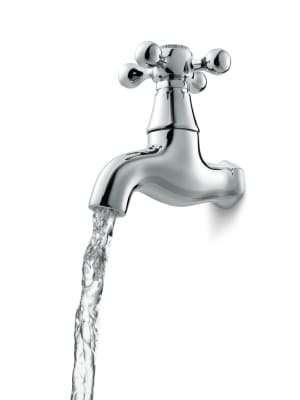
What do sinks have to do with Mashiach? The answer is: a lot! Needless to say, the month of Av is not a time for undue flippancy. It is heavy with past calamities, dragging us back to Babylonia and Rome and the destruction of two Batei Mikdash. Mourning mixed with heat and minus swimming pools do not make for happy campers. Yes, I know. Mashiach was born on Tisha B’Av and someday this birthday will become a day of rejoicing. But until Mashiach makes his appearance, we can only look forward to his coming rather than actually experience it. What we are experiencing now is ancient Babylonia morphed into Persia-Iran-Iraq and Nebuchadnezzar reincarnated into his faithful descendants – fellows like Saddam Hussein, Osama bin Laden and Ahmadinejad. As I said, Av is a hard month to get through.
Perhaps in the lands of the Diaspora, one can ignore Av to some degree. Here in Eretz Yisrael, however, there is no way you can escape the strong thread – one might say chain – binding our rocky past to our difficult present. Not only the Torah, but Jewish history continues to throb through our veins. Babylonia and Rome may be gone, but their spiritual offspring live right around the corner. All in all, it’s a heavy month. Even the few weeks after Tisha B’Av are just a short interlude until we enter Elul and stand once again, with bowed heads and prayers, before our Father in Heaven.
Yet life goes on and destruction makes way for rebirth. One very persuasive rav in Israel recently wrote that instead of continuing to mourn the Beit Hamikdash, we should begin rebuilding it! I’m not sure exactly what that entails on a national level (on a private one it surely entails doing teshuva and being better Jews) but since every Jewish home is a Mikdash M’at – a smaller version of the Temple – in our own daled amot (4 cubic feet, personal space), we are trying to do our part. We purchased an apartment in a new complex going up in our neighborhood and hopefully, it will be ready shortly.
Building, however, necessitates many materials. Both temples and homes are built with stones and bricks and lots of other things – like ceramics, floors, faucets; cabinets, windows, doors; sinks, stoves and other trivia. I prefer a finished product myself, but in this case, we had no choice but to shop and choose. In fact, there were many choices to make including the kitchen, the bathroom and the Netilat yadayim (hand washing) sinks. Not one to get overly involved in sinks, I was appalled to find that the choice of a single sink can be a daunting decision – something on the scale of coordinating the New York subway system. You wend your way between stainless steel, ceramics, natural or artificial stone, glass – multi-colored or transparent. You survey sinks in standard and non-standard shapes and sizes – round, oval, shallow, deep; sinks embedded in stone or standing upon granite slabs like monuments in some ancient temple. Colors? You name it. And they have to be coordinated with paint, cabinets, tiles and faucets (we shall not begin to discuss faucets. Faucets would fill an article of their own.)
Come to think of it, these elaborate basins bring to mind the kiyor, the large copper laver which stood in the courtyard of the Mishkan. (A new laver was later built for the Beit Hamikdash.) The copper for the Mishkan laver was donated by the women of Israel. Might that explain my deep involvement with sinks? I can’t think of any other reason I should be so mired in sinks. I have been washing my face and hands for as long as I can remember and never did I notice that one sink was measurably different from another.
So why have sinks now turned into such an issue? It’s true that I have often dreamt of having a sink for Netilat Yadayim which was large enough to contain the water spilled into it without overflowing onto the floor, but never in my wildest dreams did I think that a basin, no matter how ornate, might cost as much as a washing machine (which holds much more water and is much more useful).
All of these sink-kiyor musings eventually led to thoughts of the Beit Hamikdash which conjured up thoughts of David Hamelech. Although his son Shlomo built the Temple, it was King David, under the guidance of the prophet Samuel, who drew the plans and prepared all the materials for G-d’s House. While I stay up nights tossing and turning and thinking about sinks and things, David Hamelech had problems sleeping due to a more sublime reason. How, he asked, can I live and sleep in a royal palace when the Ark of the Covenant is housed in a mere tent? And so began the preparations for building the House of G-d.
So perhaps sinks are a sign of the Messiah after all – a reminder that it’s time to rebuild, not only our own personal homes, but Beit Hashem. And perhaps designing my own Netilat Yadayim sink is my way of getting into the swing of things, a form of practice for the real job ahead.
May our houses and homes be a “temple” for the Divine Presence, and may we be privileged to participate in the rebuilding of the actual Beit Hamikdash speedily, and in our times.
© 2008 Yaffa Ganz. Yaffa Ganz is the award winning author of more than forty Jewish juvenile titles including Sand and Stars – a 2000 year saga of Jewish history for teen readers. Her latest book – “A Different Dimension” published by Hamodia Publishers – is an anthology of essays on contemporary Jewish life.
The words of this author reflect his/her own opinions and do not necessarily represent the official position of the Orthodox Union.



